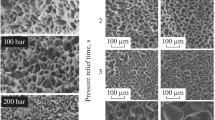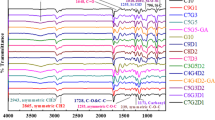Abstract
A series of polyurethane polymers was synthesized with increasing proportions of silicone in the form of polydimethylsiloxane (PDMS) utilised as a cross-linking agent, based on an aromatic, non-biostable polyetherurethane (PEtU). Eight formulations ranging from 0–50% PDMS were constructed into porous and non-porous films. These were implanted subcutaneously in rats, both unstrained and 100% strained, for 3 and 6 months. Degradation was determined by FTIR-ATR. Porous films were implanted for 6 and 12 months intramuscularly in both rats and rabbits. These were explanted and examined for inflammatory cell markers by immunohistochemistry. Both low and high percentages of siloxane gave rise to increased degradation, with 20–40% PDMS resulting in the least degradation. Infrared spectral changes correlated well with both visual examination and observation by SEM. Changes to the concentration of siloxane gave rise to differences in the thickness of fibroblastic capsule and infiltration of inflammatory cells in both films & scaffolds. Cellular infiltration was greatest in the films with lower siloxane concentrations. Macrophage activation (MHC-I & MHC-II expression) was least in the higher siloxane variants. It is concluded that by varying the siloxane content in the PEtU matrix we can obtain an acceptable inflammatory response with a relatively short degradation time.
Similar content being viewed by others
References
M. SZYCHER, in “Blood Compatible Materials and Devices” (Technomic Publishing Co, Lancaster, PA, 1990) p. 33.
H. J. GRIESSER, Polym. Degrad. Stab. 33 (1991) 329.
J. P. SANTERRE and R. S. LABOW, J. Biomed. Mater. Res. 36 (1997) 223.
M. A. SCHUBERT,M. J. WIGGINS, M. P. SCHAEFER, A. HILTNER and J. M. ANDERSON, J. Biomed. Mater. Res. 29 (1995) 337.
D. J. TYLER and B. D. RATNER, J. Biomater. Sci. Polym. Ed. 6 (1994) 359.
J. M. ANDERSON, ASAIO Trans. 34 (1988) 101.
J. A. HUNT, B. F. FLANAGAN, P. J. MCLAUGHLIN, I. STRICKLAND and D. F. WILLIAMS, J. Biomed. Mater. Res. 31 (1996) 139.
B. L. SEAL, T. C. OTERO and A. PANITCH, Mater. Sci. Eng. R34 (2001) 147.
G. SOLDANI, G. PANOL, H. F. SASKEN, M. B. GODDARD and P. M. GALLETTI, J. Mater. Sci.: Mater. Med. 3 (1992) 106.
T. OKOSHI, H. CHEN, G. SOLDANI, P. M. GALLETTI and M. GODDARD, ASAIO J. 38 (1992) M201.
Author information
Authors and Affiliations
Corresponding author
Rights and permissions
About this article
Cite this article
Rhodes, N.P., Bellón, J.M., Buján, M.J. et al. Inflammatory response to a novel series of siloxane-crosslinked polyurethane elastomers having controlled biodegradation. J Mater Sci: Mater Med 16, 1207–1211 (2005). https://doi.org/10.1007/s10856-005-4730-7
Received:
Accepted:
Issue Date:
DOI: https://doi.org/10.1007/s10856-005-4730-7




